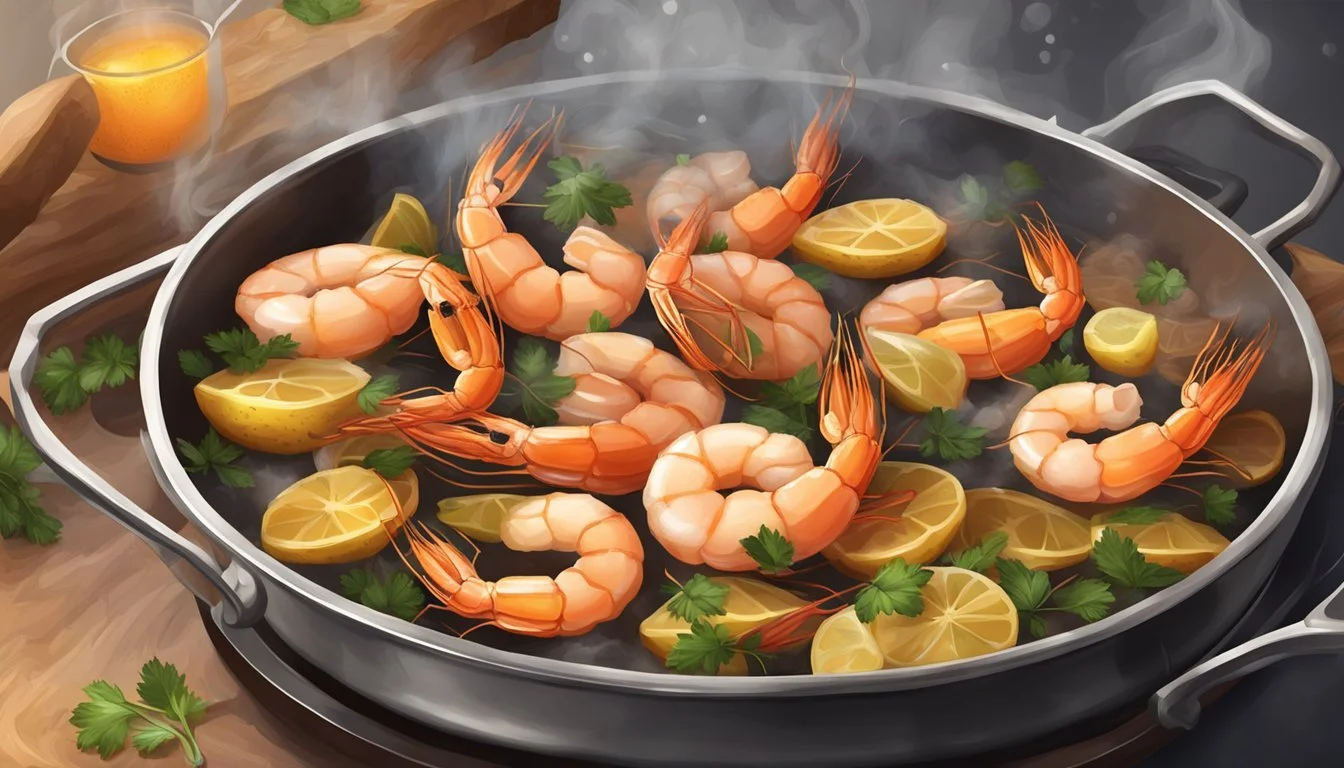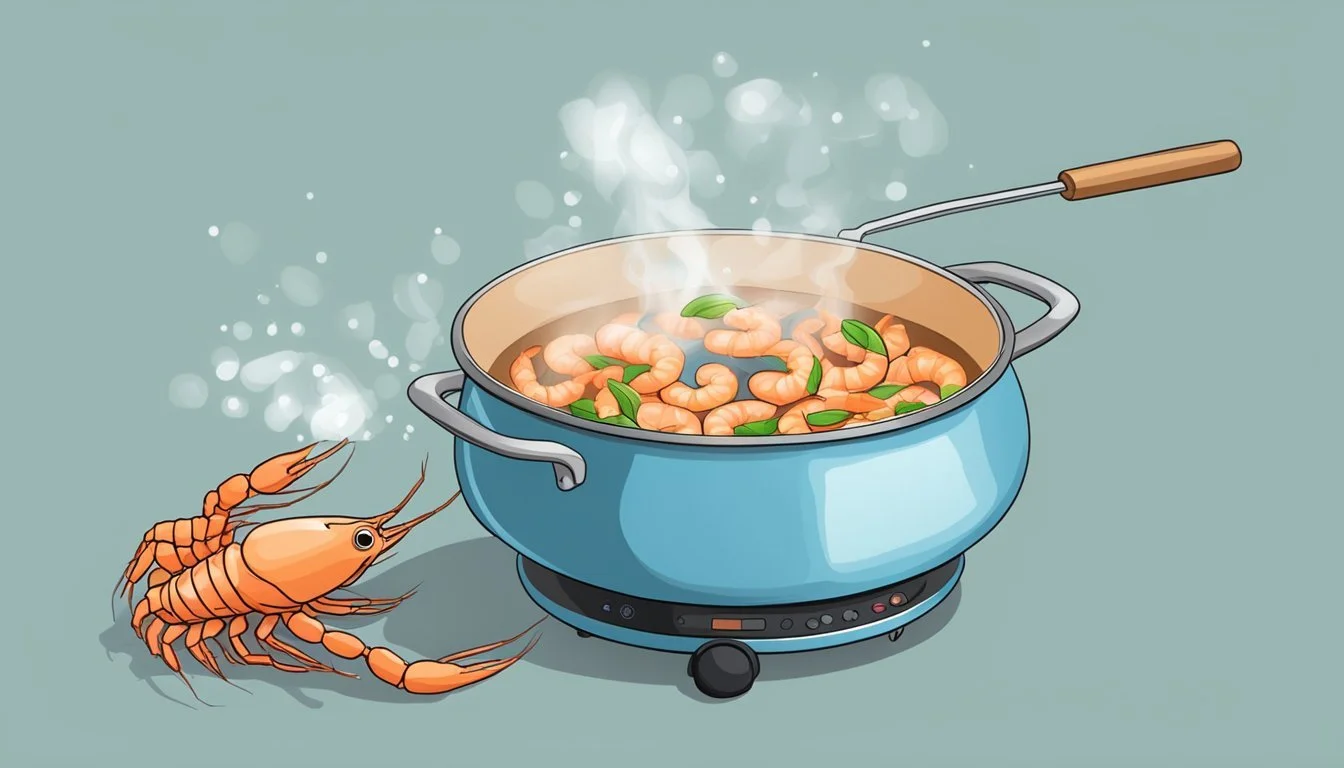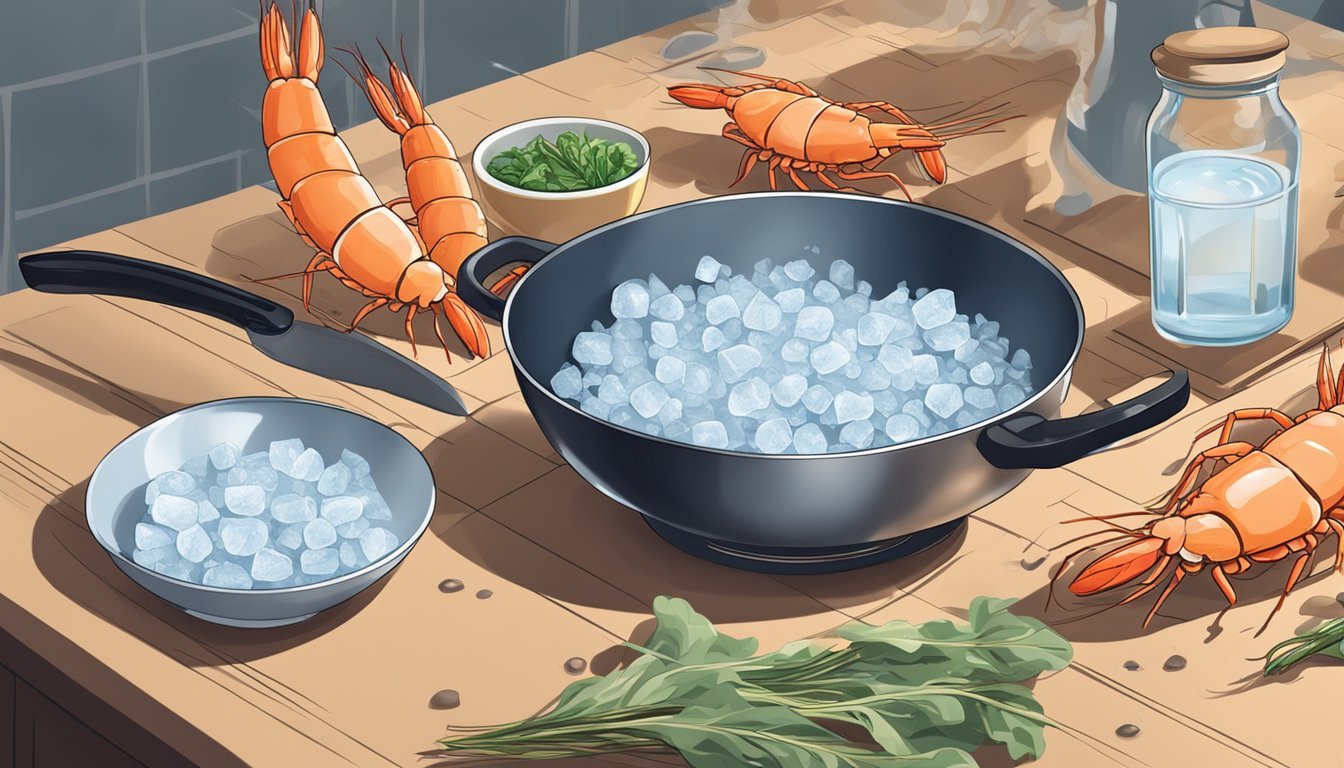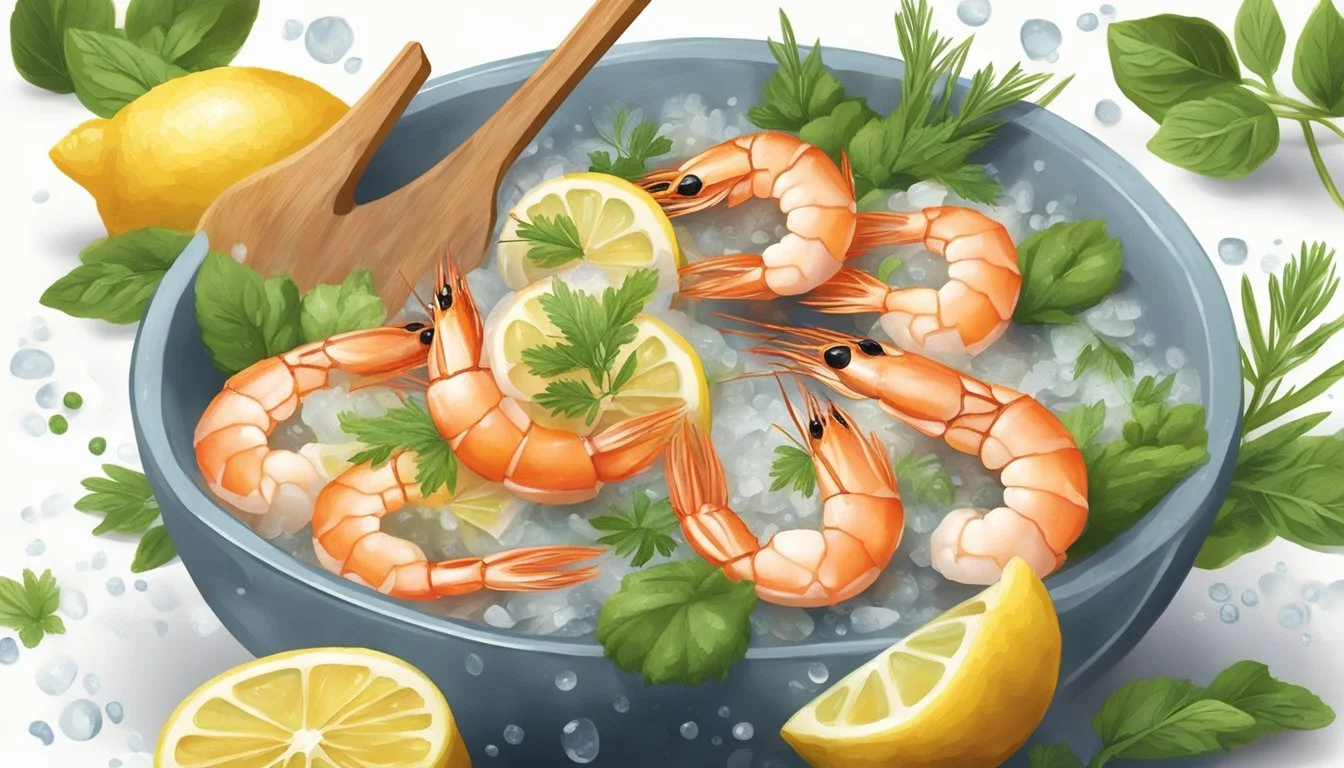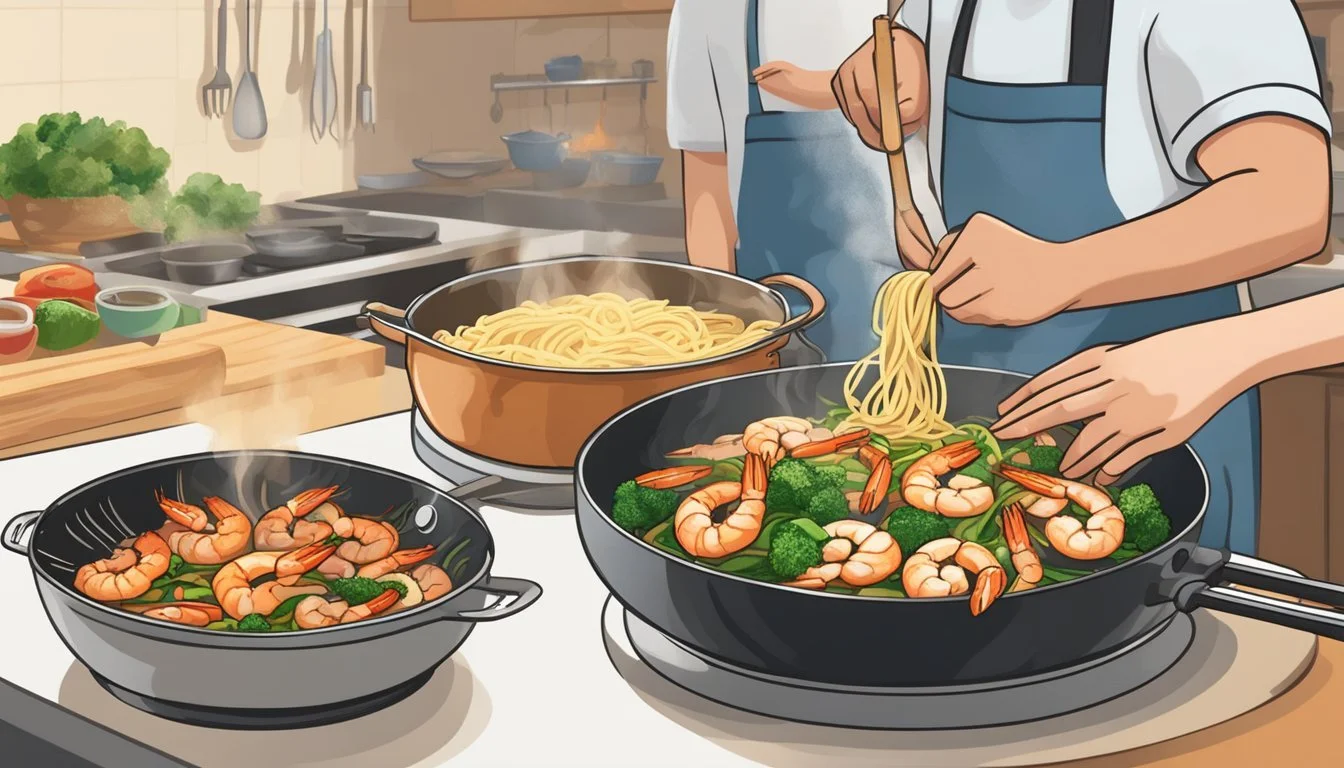Saving Overcooked Shrimp
Tips for Restoring Tender and Juicy Seafood
Overcooking shrimp (What wine goes well with shrimp?) is a common kitchen mishap, often leading to a tough and rubbery texture that can overshadow the delicate taste of this popular seafood. Shrimp cooks quickly, which means it’s easy to miss the narrow window of perfectly tender results. However, even when overcooked, shrimp doesn’t need to be a lost cause. Culinary techniques and simple kitchen hacks can breathe new life into these little crustaceans, transforming them back to a succulent state that can still delight the palate.
Addressing overcooked shrimp requires an understanding of their delicate nature. Because shrimp are lean and composed mostly of protein, they lack the fatty insulation that helps to prevent overcooking. Therefore, once they’ve been cooked too long and the proteins have contracted, conventional cooking wisdom might suggest that there is no remedy. Despite this, a few innovative methods allow one to counteract the effects of overcooking. By reintroducing moisture and breaking down the contracted proteins, there is hope for restoring overcooked shrimp to a tender and more juicy condition. These methods focus on the use of a brine solution, lemon juice, or other creative culinary techniques.
Understanding Shrimp Cooking Basics
Shrimp cooking requires precision to ensure they turn out juicy rather than dry. Shrimp should be cooked on high heat for a short duration to achieve the desired tenderness. The cooking time is critical; typically, shrimp need only 2-3 minutes per side to cook thoroughly. If shrimp are left on the heat too long, they become tough and overcooked.
To begin, one should season the shrimp appropriately. A simple combination of salt, and a dash of lemon juice can enhance the natural flavors of the shrimp. While cooking, it is essential to use the right amount of oil to prevent the shrimp from sticking to the pan and to help distribute heat evenly.
The shrimp are perfectly cooked when they achieve a pink and opaque appearance. This is an indicator that shrimp have reached the ideal internal temperature without overcooking.
Below is a brief guide on the cooking process:
Preparation:
Season shrimp with salt and a squeeze of lemon juice.
Coat lightly with oil to prevent sticking.
Heat the pan on high heat before adding the shrimp.
Place shrimp in the pan in a single layer.
Cook for 2 to 3 minutes until the side facing down is pink and opaque.
Flip and cook for another 2 to 3 minutes.
Checking Doneness:
Look for the pink and opaque color as an indicator of doneness.
Avoid overcooking to prevent shrimp from becoming rubbery.
By following these basics, cooks can ensure their shrimp retain moisture and a tender texture, achieving the perfection that makes for a delightful seafood experience.
Signs and Prevention of Overcooking Shrimp
Recognizing Overcooked Shrimp: Overcooked shrimp are typically firm and rubbery, offering a less palatable texture compared to their perfectly cooked counterparts. These shrimp tend to curl into a tight "C" shape, a clear visual cue that they have been on the heat for too long.
Characteristics of Perfectly Cooked Shrimp: They should retain a tender and juicy interior. The ideal shape is a loose "C", indicating they are just right. The flesh should be a uniform pink without any grayish spots.
How to Avoid Overcooking
Monitor Cooking Time: Shrimp cook very quickly, usually within two to three minutes. Keep a close watch to avoid crossing the line from tender to rubbery.
Use Residual Heat:
Start with boiling water: Add shrimp to boiling water.
Cover and remove from heat: The residual heat poaches the shrimp gently.
Check at intervals: After 5 minutes, verify doneness.
Visual Inspection: As shrimp cooks, observe the color change to pink and formation into a loose "C" for a sign that they are ready.
Cooking Methods:
Boiling: A swift method that requires vigilance to prevent overcooking.
Baking: At 350°F (175°C), shrimp may need 10-12 minutes; watch carefully for signs of being perfectly cooked.
Temperature Tips
Lower temperatures are favorable, as high heat can quickly push shrimp past the point of being tender and juicy. For certain recipes, taking shrimp off the heat just before they’re done allows them to reach perfect doneness with residual warmth. This gentle finish ensures they remain moist and full of flavor.
Ingredients Impacting Shrimp Quality
The quality of shrimp can be profoundly influenced by the ingredients used in its preparation. Certain components are key in achieving the optimal balance of flavor and texture.
Salt, including kosher salt, is essential for seasoning, as it enhances the natural sweetness of the shrimp. When combined with water to create a brining solution, salt not only seasons but also helps keep the shrimp moist and tender.
Incorporating sugar into the brine can also help balance the saline flavor, while promoting a subtle sweetness. For instance:
Brine Solution: 1 quart of water with 1/4 cup kosher salt and 2 tablespoons sugar.
Oil plays a dual role; it prevents shrimp from sticking to cookware and contributes to the flavor profile. Olive oil is preferred for its health benefits and mild taste, which does not overpower the shrimp. Similarly, butter can be used to add a rich, smooth finish to the seafood.
Shrimp's flavor can be elevated with a careful selection of seasonings. A dash of black pepper adds heat without overwhelming the primary taste, while garlic imparts aromatic depth.
For a fresh, citrus note, lemon zest acts as an accent that complements shrimp's flavor exquisitely. To finish, a garnish of fresh parsley not only adds a pop of color but also a clean, slightly peppery taste that rounds out the dish.
Example Seasoning Mix (per 1 lb of shrimp):
1 tsp kosher salt
1/2 tsp black pepper
1 tbsp olive oil or melted butter
2 minced garlic cloves
1/2 tsp lemon zest
2 tbsp chopped fresh parsley
Each ingredient should be measured and used judiciously to preserve the delicate nature of shrimp while enhancing its inherent flavors.
Tools and Techniques for Preparing Shrimp
When preparing shrimp, having the right tools can make a significant difference in the outcome. A nonstick skillet is essential for achieving a good sear without sticking, especially when cooking on a stovetop. For those who prefer grilling, skewers are a must-have to keep the shrimp from falling through the grates. Metal skewers are reusable and sturdy, while wooden skewers should be soaked in water to prevent burning.
Before cooking shrimp, whether frozen or fresh, it's important to rinse them thoroughly in a bowl of cold water to remove any debris or excess ice. This is particularly critical if the shrimp are going from frozen to cooked without a full thaw. Preheating the cooking surface—be it the grill, the oven, or a hot pan—ensures that the shrimp begin cooking as soon as they hit the surface, sealing in juices for tender flesh.
Here's a simple preparation technique:
Preheat the cooking equipment to the appropriate temperature.
For grilling: Medium-high heat works best.
For oven roasting: Preheat to 400°F (200°C).
For pan-frying: Medium-high heat until the pan is hot.
While the equipment is preheating, rinse the shrimp in a bowl of cold water.
If using frozen shrimp, allow them to thaw partially in the bowl to ensure even cooking.
Sear the shrimp on the preheated surface, using a method that fits the chosen equipment:
For skewered grilling, place shrimp directly onto the grill and cook for 2-3 minutes per side.
In a nonstick skillet, cook in batches to not overcrowd the pan, about 1-2 minutes per side.
Keep a close eye on the shrimp; they cook quickly and are best removed from heat as soon as they turn pink.
By following these techniques, cooks ensure that their shrimp are handled with care, resulting in a tender and juicy seafood dish.
Corrective Measures for Overcooked Shrimp
If one finds themselves with overcooked shrimp, there are several strategies that can be employed to improve the texture and flavor.
Brine Soaking: To revive the tenderness of overcooked shrimp, soaking them in a brine solution is often recommended. A basic brine can be made by mixing water, salt, and a little sugar. Shrimps should be submerged in this solution for approximately 15 to 30 minutes.
Ingredient Amount for 1 lb of Shrimp Water 2-3 cups Salt 1 tablespoon Sugar 1 teaspoon
After brining, it's crucial to pat the shrimp dry to remove excess moisture.
Lemon Juice: The acidity in lemon juice can soften the tough texture of the overcooked shrimp. Soaking the shrimp in lemon juice for about 30 minutes not only helps with texture but also adds a citrus flavor that can enhance the overall taste.
Baking Soda: A quick alternative involves using baking soda to tenderize the shrimp. Combine a teaspoon of kosher salt with a quarter teaspoon of baking soda and toss the shrimp in the mixture. Let them rest in the refrigerator for 15 minutes to an hour.
Poaching: For shrimp that are only slightly overcooked, gently poaching them in a bath of olive oil at a very low temperature can help to soften their texture without cooking them further. This method should be done delicately to avoid further overcooking.
By using these methods, one can often salvage overcooked shrimp, converting them into a more palatable and tender seafood experience.
Flavor Enhancement Post-Cooking
Once shrimp are overcooked, their flavor and moistness can become compromised. However, post-cooking techniques can help revitalize their taste.
Marinating offers a great way to infuse flavor back into the shrimp. A simple marinade can be made using olive oil as a base, combined with acidic components such as lemon juice. This not only adds zest but also helps to tenderize the shrimp further.
Adding seasonings and herbs can make a significant impact. Here is a list of suggested seasonings that pair well with shrimp:
Garlic: Adds a pungent and aromatic flavor.
Ginger: Brings a warm, spicy kick.
Cilantro: Provides a fresh, citrusy note.
Thyme: Offers a subtle, earthy tone.
For a bit of heat, sprinkling red pepper flakes, cayenne pepper, or dusting with a bit of paprika will introduce a fiery dimension to the shrimp.
Table 1: Seasoning Mix
Ingredients Quantity Olive Oil 2 tbsp Lemon Juice 1 tbsp Garlic 1 tsp, minced Red Pepper Flakes 1/4 tsp Black Pepper To taste Thyme 1/2 tsp, dried
Sautéing in a combination of butter and olive oil provides not only flavor but also helps to achieve a desirable texture. However, it's essential to be careful with the cooking time to avoid further toughening the shrimp.
Incorporating soy sauce can give a umami flavor that complements shrimp well, especially when combined with ginger and garlic.
Ultimately, the key to flavor enhancement lies in balancing savory with acid, heat, and aromatics to complement the natural sweetness of shrimp.
Serving and Presentation of Shrimp
When presenting shrimp, whether it’s in a salad, cocktail, or tacos, the key is simplicity and freshness. A simple drizzle of lemon juice can brighten the flavor and add a zesty note to the dish.
Shrimp Salad:
Base: Start with a mix of fresh greens.
Dressing: A light vinaigrette pairs well.
Garnish: Add a wedge of lemon for squeezing.
Shrimp Cocktail: (What wine goes well with shrimp cocktail?)
Glassware: Serve in a chilled martini or cocktail glass.
Sauce: Classic cocktail sauce should be tangy and spicy.
Extra: Include a slice of lemon on the rim.
Shrimp Tacos:
Tortillas: Warm and slightly charred works best.
Toppings: Fresh salsa, avocado slices, and a squeeze of lime enhance flavors.
Herbs: A sprinkle of cilantro can elevate the overall taste.
In any presentation, the shrimp should be the star. It’s essential to not overpower its delicate, flavorful nature with too many competing flavors. Moreover, one must ensure that the shrimp is not overcooked when it’s incorporated into the dish to maintain the optimal dining experience. A visually appealing arrangement that speaks to the freshness and quality of the ingredients can turn a simple dish into a flavorful experience that delights the senses.
Storing and Reheating Shrimp
Storing cooked shrimp properly is crucial for maintaining their quality. To keep overcooked shrimp from becoming tougher, they should be stored in an airtight container. If refrigerating, they can be kept for up to three days. For longer storage, freezing is an option. Place them in an airtight container or a heavy-duty freezer bag to prevent freezer burn.
When the time comes to reheat the shrimp, the goal is to make them as tender and juicy as possible.
Here's the best way to reheat shrimp:
Thawing: If frozen, transfer the shrimp to the refrigerator overnight to thaw gradually.
Preparation: Take the shrimp out of the container and let them reach room temperature for a few minutes before reheating.
Methods of Reheating:
Microwave: Place shrimp in a microwave-safe dish with a small amount of water. Cover and heat on 50% power in 30-second intervals, stirring in between, until warm.
Skillet: Heat shrimp in a skillet on low heat with a tablespoon of butter or broth. Add a lid after a minute to trap moisture.
Key Reheating Tips:
Always use low heat to prevent further overcooking.
Adding moisture, like a splash of water or broth, can help shrimp regain tenderness.
Brief heating time is sufficient. Prolonged exposure to heat will dry out the shrimp.
By following these storage and reheating techniques, one can enhance the succulence of overcooked shrimp and enjoy a more palatable seafood experience.
Incorporating Shrimp into Various Dishes
When shrimp has been overcooked, it often becomes firm and less appealing directly on its own. However, one can incorporate it into various dishes to enhance its texture and flavor. A range of recipes can repurpose overcooked shrimp into delectable meals.
Stir-Fry or Fried Rice: Chopping overcooked shrimp into small pieces and incorporating them into a vegetable stir-fry (What Wine Pairs Perfectly With Vegetable Stir-Fry?) or fried rice not only masks the firm texture but also adds a rich seafood flavor to the dish.
Shrimp Salad: By shredding overcooked shrimp, one can add it to a shrimp salad. The firm texture of the shrimp provides a pleasant contrast to the fresh, crisp vegetables, and the dressing helps to moisten and flavor the shrimp.
Creamy Pasta: Overcooked shrimp can be minced and mixed into a creamy pasta sauce, which can help revitalize its juiciness and infuses the pasta with a savory seafood essence.
Shrimp Cocktail: For a simple fix, one can slice the overcooked shrimp and serve with a bold cocktail sauce. The firmness here is actually beneficial as it holds up well when dipped.
Here is a simple table summarizing how to incorporate overcooked shrimp into different dishes:
Dish Type Preparation Method Accompanying Ingredients Stir-Fry Chop and mix with vegetables, season with sauces. Bell peppers, broccoli, soy sauce Fried Rice Mix small pieces into rice with vegetables and egg. Peas, carrots, onions, egg Shrimp Salad Shred and combine with greens and a vinaigrette. Lettuce, tomatoes, cucumber Creamy Pasta Mince and stir into a creamy sauce. Pasta, cream, garlic Shrimp Cocktail Slice and serve chilled with cocktail sauce. —
One can also sweeten the deal by adding honey to glazes or marinades when preparing these dishes, offering a sweet counterpart to the shrimp's savory notes. The versatility of overcooked shrimp in various recipes ensures that even less-than-perfectly cooked seafood can still star in a flavorful and satisfying meal.
Tips for Buying and Preparing Shrimp
When purchasing shrimp, buyers have options between frozen or fresh shrimp. Frozen shrimp are convenient as they can be stored for longer periods, but one should ensure that they are free from ice crystals or frost, signs of thawing and refreezing. Fresh shrimp should have a mild, sea-breeze aroma. It's essential to avoid any with strong, off-putting odors.
Deveining shrimp is a common preparation step. While not always necessary from a safety standpoint, it can improve the appearance and texture of both raw and cooked shrimp. Deveined shrimp means the digestive tract has been removed, which is especially desirable for larger, jumbo shrimp.
Shrimp may be bought with shells on or off. Shell-on shrimp often retains more flavor and moisture through the cooking process but requires additional preparation before consumption. Conversely, peeled shrimp are more convenient and reduce the need for diner interaction during the meal.
When handling raw shrimp, it's vital to keep them refrigerated until it's time to cook and to not overcook them. Overcooking shrimp can result in a tough, rubbery texture. Here's a quick guide for cooking methods:
Boiling: Cook the shrimp for 1-3 minutes in rapidly boiling water.
Sautéing: Cook for 1-2 minutes on one side, then flip and cook for an additional 1-2 minutes, depending on size.
Shrimp preparation and cooking times vary with size, with larger shrimp typically requiring slightly longer cooking periods. Always observe the shrimp's color; they are done when they turn a pinkish hue with a slight opacity.
Advanced Cooking Methods for Shrimp
When cooking shrimp, one can employ several advanced techniques that enhance flavor and texture, making this versatile seafood a focal point of any healthy dinner.
Grilling shrimp involves high, direct heat, which can imbue a gentle smokiness. It's essential to use fresh shrimp, as they retain firmness better during the grilling process. One should lightly coat them with oil, season with sea salt and choice seasonings, and place them on the grill. To prevent overcooking, the shrimp should be grilled for just 2-3 minutes on each side until a slight browning is noticeable. Always flip them just once to ensure even cooking.
Poached shrimp offer a gentler cooking method. Cooks submerge shrimp in a flavored liquid, bringing out their delicate taste without the risk of toughening that comes with high heat. The poaching liquid often includes a mixture of water, seasonings, and sometimes lemon for an added zest.
For a more controlled heat approach, baking is preferred. Arrange the shrimp in a single layer on a baking sheet, brush them with melted butter or oil, and sprinkle with seasonings before placing them in a preheated oven. The baking time is usually short, as the shrimp complete the browning process quickly—often in as little as 5-7 minutes.
Given shrimp are a favorite protein for many, these methods not only save overcooked shrimp but expand the repertoire of even the most seasoned home chefs. Whether grilled, poached, or baked, shrimp can remain the star of a tender, juicy, and perfectly browned seafood dish.

